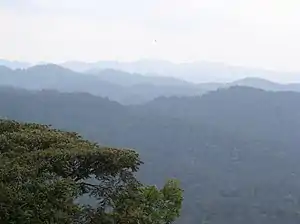Bwindi Impenetrable Forest
The Bwindi Impenetrable Forest is a large primeval forest located in south-western Uganda in the Kanungu District. The forest is on the edge of the Albertine Rift, the western branch of the East African Rift, at elevations ranging from 1,160 to 2,607 metres (3,806 to 8,553 ft).

"Bwindi" is derived from the Runyakitara word "Mubwindi" and means "a place full of darkness".[1] This name comes from the extensive stands of bamboo interspersed amongst the larger forest hardwoods. The bamboo and thick ground cover of ferns, vines, and other plant growth severely hinder direct access on foot.[2] Also known as the "Place of Darkness", the forest is on the edge of the western arm of the Great Rift Valley, only a few kilometers from the Democratic Republic of the Congo (DRC) border and about 25 kilometres (16 mi) north of the Virunga Mountains.
The forest is one of the most biologically diverse areas on Earth, where half the world's population of the highly endangered mountain gorillas live in its jungles. The forest has been recognized by the United Nations Educational, Scientific and Cultural Organization as a World Heritage Site for its biological significance.
The forest has been described as "Riven by disputes and crosshatched by historical, political, and biological borders" by researcher Craig Stanford, co-director of the park's Jane Goodall Research Center. In 1991, the Bwindi Impenetrable National Park was established, adjacent to the strife-torn Uganda, Rwanda, and DRC border region.
References
- "Bwindi Impenetrable National Park Gorilla Trekking". Archived from the original on 19 September 2013. Retrieved 22 December 2013.
- "Bwindi Impenetrable National Park - UNESCO World Heritage Centre". Retrieved 22 December 2013.